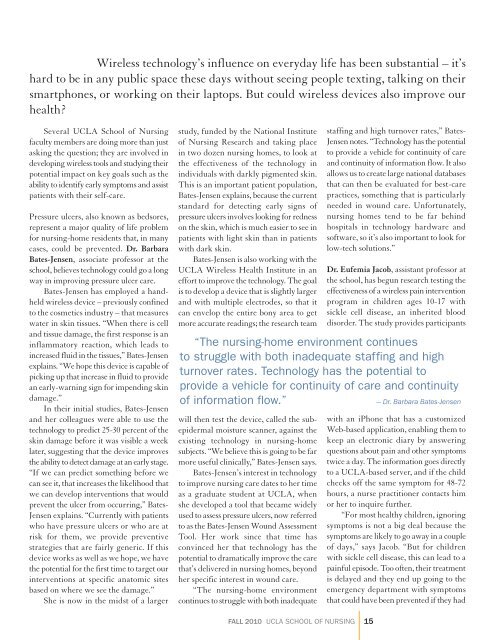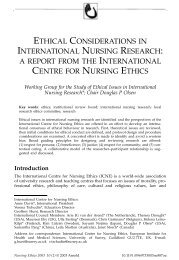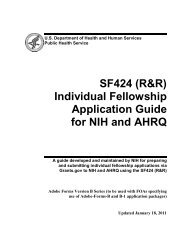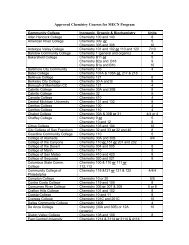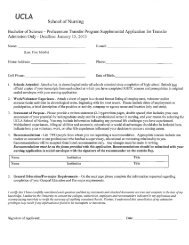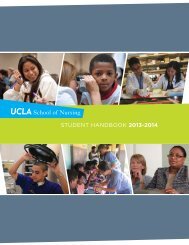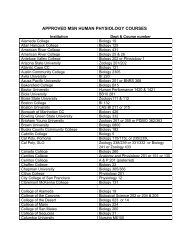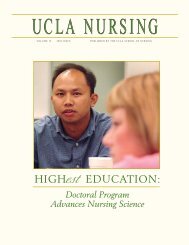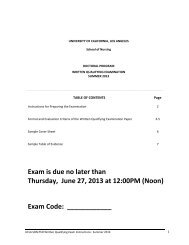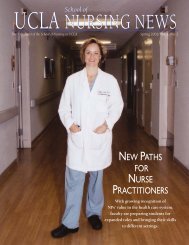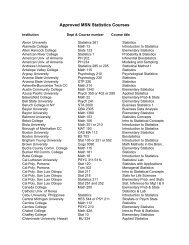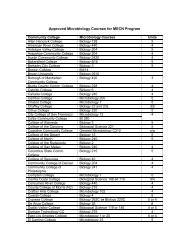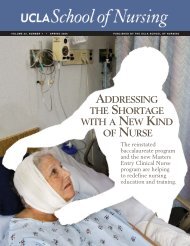proof positive - UCLA School of Nursing
proof positive - UCLA School of Nursing
proof positive - UCLA School of Nursing
You also want an ePaper? Increase the reach of your titles
YUMPU automatically turns print PDFs into web optimized ePapers that Google loves.
Wireless technology’s influence on everyday life has been substantial – it’s<br />
hard to be in any public space these days without seeing people texting, talking on their<br />
smartphones, or working on their laptops. But could wireless devices also improve our<br />
health<br />
Several <strong>UCLA</strong> <strong>School</strong> <strong>of</strong> <strong>Nursing</strong><br />
faculty members are doing more than just<br />
asking the question; they are involved in<br />
developing wireless tools and studying their<br />
potential impact on key goals such as the<br />
ability to identify early symptoms and assist<br />
patients with their self-care.<br />
Pressure ulcers, also known as bedsores,<br />
represent a major quality <strong>of</strong> life problem<br />
for nursing-home residents that, in many<br />
cases, could be prevented. Dr. Barbara<br />
Bates-Jensen, associate pr<strong>of</strong>essor at the<br />
school, believes technology could go a long<br />
way in improving pressure ulcer care.<br />
Bates-Jensen has employed a handheld<br />
wireless device – previously confined<br />
to the cosmetics industry – that measures<br />
water in skin tissues. “When there is cell<br />
and tissue damage, the first response is an<br />
inflammatory reaction, which leads to<br />
increased fluid in the tissues,” Bates-Jensen<br />
explains. “We hope this device is capable <strong>of</strong><br />
picking up that increase in fluid to provide<br />
an early-warning sign for impending skin<br />
damage.”<br />
In their initial studies, Bates-Jensen<br />
and her colleagues were able to use the<br />
technology to predict 25-30 percent <strong>of</strong> the<br />
skin damage before it was visible a week<br />
later, suggesting that the device improves<br />
the ability to detect damage at an early stage.<br />
“If we can predict something before we<br />
can see it, that increases the likelihood that<br />
we can develop interventions that would<br />
prevent the ulcer from occurring,” Bates-<br />
Jensen explains. “Currently with patients<br />
who have pressure ulcers or who are at<br />
risk for them, we provide preventive<br />
strategies that are fairly generic. If this<br />
device works as well as we hope, we have<br />
the potential for the first time to target our<br />
interventions at specific anatomic sites<br />
based on where we see the damage.”<br />
She is now in the midst <strong>of</strong> a larger<br />
study, funded by the National Institute<br />
<strong>of</strong> <strong>Nursing</strong> Research and taking place<br />
in two dozen nursing homes, to look at<br />
the effectiveness <strong>of</strong> the technology in<br />
individuals with darkly pigmented skin.<br />
This is an important patient population,<br />
Bates-Jensen explains, because the current<br />
standard for detecting early signs <strong>of</strong><br />
pressure ulcers involves looking for redness<br />
on the skin, which is much easier to see in<br />
patients with light skin than in patients<br />
with dark skin.<br />
Bates-Jensen is also working with the<br />
<strong>UCLA</strong> Wireless Health Institute in an<br />
effort to improve the technology. The goal<br />
is to develop a device that is slightly larger<br />
and with multiple electrodes, so that it<br />
can envelop the entire bony area to get<br />
more accurate readings; the research team<br />
will then test the device, called the subepidermal<br />
moisture scanner, against the<br />
existing technology in nursing-home<br />
subjects. “We believe this is going to be far<br />
more useful clinically,” Bates-Jensen says.<br />
Bates-Jensen’s interest in technology<br />
to improve nursing care dates to her time<br />
as a graduate student at <strong>UCLA</strong>, when<br />
she developed a tool that became widely<br />
used to assess pressure ulcers, now referred<br />
to as the Bates-Jensen Wound Assessment<br />
Tool. Her work since that time has<br />
convinced her that technology has the<br />
potential to dramatically improve the care<br />
that’s delivered in nursing homes, beyond<br />
her specific interest in wound care.<br />
“The nursing-home environment<br />
continues to struggle with both inadequate<br />
staffing and high turnover rates,” Bates-<br />
Jensen notes. “Technology has the potential<br />
to provide a vehicle for continuity <strong>of</strong> care<br />
and continuity <strong>of</strong> information flow. It also<br />
allows us to create large national databases<br />
that can then be evaluated for best-care<br />
practices, something that is particularly<br />
needed in wound care. Unfortunately,<br />
nursing homes tend to be far behind<br />
hospitals in technology hardware and<br />
s<strong>of</strong>tware, so it’s also important to look for<br />
low-tech solutions.”<br />
Dr. Eufemia Jacob, assistant pr<strong>of</strong>essor at<br />
the school, has begun research testing the<br />
effectiveness <strong>of</strong> a wireless pain intervention<br />
program in children ages 10-17 with<br />
sickle cell disease, an inherited blood<br />
disorder. The study provides participants<br />
“The nursing-home environment continues<br />
to struggle with both inadequate staffing and high<br />
turnover rates. Technology has the potential to<br />
provide a vehicle for continuity <strong>of</strong> care and continuity<br />
<strong>of</strong> information flow.”<br />
— Dr. Barbara Bates-Jensen<br />
with an iPhone that has a customized<br />
Web-based application, enabling them to<br />
keep an electronic diary by answering<br />
questions about pain and other symptoms<br />
twice a day. The information goes directly<br />
to a <strong>UCLA</strong>-based server, and if the child<br />
checks <strong>of</strong>f the same symptom for 48-72<br />
hours, a nurse practitioner contacts him<br />
or her to inquire further.<br />
“For most healthy children, ignoring<br />
symptoms is not a big deal because the<br />
symptoms are likely to go away in a couple<br />
<strong>of</strong> days,” says Jacob. “But for children<br />
with sickle cell disease, this can lead to a<br />
painful episode. Too <strong>of</strong>ten, their treatment<br />
is delayed and they end up going to the<br />
emergency department with symptoms<br />
that could have been prevented if they had<br />
fall 2010 <strong>UCLA</strong> SCHOOL OF NURSING 15


